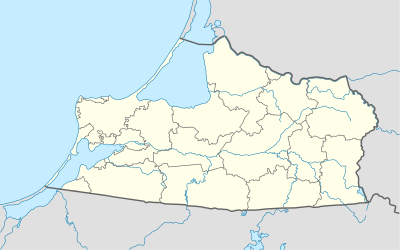Zheleznodorozhny, Kaliningrad Oblast
Zheleznodorozhny (Russian: Железнодоро́жный, lit. railway (town); until 1946 German: Gerdauen; Polish: Gierdawy; Lithuanian: Girdava), is an urban locality (an urban-type settlement) in Pravdinsky District of Kaliningrad Oblast, Russia. It is located 69 km (43 miles) south-east of Kaliningrad, near the border with Poland, and had a population in 2017 of 2,728.
Zheleznodorozhny Железнодоро́жный | |
|---|---|
Town | |
 Former Gerdauen town hall | |
.png) Flag  Coat of arms | |
Location of Zheleznodorozhny 
| |
 Zheleznodorozhny Location of Zheleznodorozhny  Zheleznodorozhny Zheleznodorozhny (Kaliningrad Oblast) | |
| Coordinates: 54°21′40″N 21°18′42″E | |
| Country | Russia |
| Federal subject | Kaliningrad Oblast |
| Administrative district | Pravdinsky District |
| Founded | 13th century[1] |
| Elevation | 35 m (115 ft) |
| Population | |
| • Total | 2,767 |
| • Estimate (2018)[3] | 2,676 (-3.3%) |
| Time zone | UTC+2 (MSK–1 |
| Postal code(s)[5] | 238410 |
| OKTMO ID | 27719000052 |
History
A fortification of the Old Prussians existed in the Zheleznodorozhny area, possibly since the 9th century, however German settlers only arrived sometime in the late 13th or early 14th century. The settlers came in connection with the construction of a castle of the Teutonic Order, which is mentioned as completed in written sources from 1315 and 1325. A lischke was formed around the castle, and was attacked by Lithuanians in 1336, 1347 and 1366, but prospered and in 1398 received Kulm law (city status) by the Grand Master of the Teutonic Order Konrad von Jungingen. A town wall was erected in 1406, a school in 1409, and a Dominican monastery was also established in the town. From 1469 the town was no longer under control of the Teutonic Order, but a fief of the von Schlieben family, who built a new castle for themselves in the town. The castle in Gerdauen had been partially destroyed in battle in 1455, and was abandoned by 1672. Gerdauen was damaged from fire in 1485 after being burnt by Polish troops, and suffered further fires in 1585 and 1665. In 1809 Gerdauen ceased to be a fief, and a railway connection to the town was established in 1871. The ruins of the old Gerdauen castle served as the foundation for the construction of a residential building in 1874, with the large cellar of the castle incorporated into the new building.
Gerdauen was heavily damaged during fighting in World War I, but later rebuilt with monetary assistance from Wilmersdorf in Berlin, and the city of Budapest, Hungary. It prospered due to the malt processing industry and a large brewery, and in 1937 it had 5,152 inhabitants. Gerdauen was damaged again during World War II, and following the war the town and much of East Prussia became a part of the Soviet Union. The German population was expelled and replaced with mostly Russian settlers, with the Soviet portion of East Prussia being organized into Kaliningrad Oblast. In 1946 the name was changed from Gerdauen to its current name Zheleznodorozhny.[6] After the collapse of the Soviet Union in 1991, Zheleznodorozhny became a part of the Russian Federation.
Demographics
Ethnic composition
Russian - 83.3%, Belarusians - 6.3%, Ukrainians - 3.8%, Germans - 2.3%, Armenians - 2.1%, Poles - 0.6%, Others - 1.6%
Notable people
- Theodor Gottlieb von Hippel the Elder (1741–1796), satirical writer
- Theodor Gottlieb von Hippel the Younger (1775–1837), jurist
- Wilhelm Steputat (1868-1941), author, jurist, politician
- Reinhold Rehs (1901 in Klinthenen – 1971) German politician and chairman of the Federation of Expellees in 1967-70
- Hans Jenisch (1913–1982), U-boat commander
- Wolfgang Bernhard Jurkat (1929-2017), mathematician
- Hinrich Kuessner (born 1943), SPD-politician in Mecklenburg-Vorpommern
References
- Энциклопедия Города России. Moscow: Большая Российская Энциклопедия. 2003. p. 361. ISBN 5-7107-7399-9.
- Russian Federal State Statistics Service (2011). "Всероссийская перепись населения 2010 года. Том 1" [2010 All-Russian Population Census, vol. 1]. Всероссийская перепись населения 2010 года [2010 All-Russia Population Census] (in Russian). Federal State Statistics Service.
- "26. Численность постоянного населения Российской Федерации по муниципальным образованиям на 1 января 2018 года". Federal State Statistics Service. Retrieved January 23, 2019.
- "Об исчислении времени". Официальный интернет-портал правовой информации (in Russian). June 3, 2011. Retrieved January 19, 2019.
- Почта России. Информационно-вычислительный центр ОАСУ РПО. (Russian Post). Поиск объектов почтовой связи (Postal Objects Search) (in Russian)
- Weise, Erich, ed. (1981) [1966]. Handbuch der historischen Stätten. Ost- und Westpreussen (in German). Stuttgart: Kröner. p. 64-65. ISBN 3-520-31701-X.